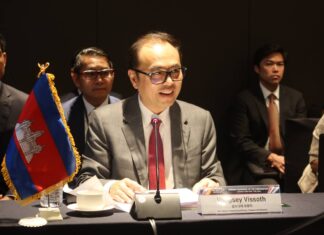[2]
(1) Principles of the Tonle Sap Lake management – demarcation, mounting frontier poles, land registration and prevention of further encroachment
On January 30, 2024, on the occasion of the closing meeting of the Ministry of Agriculture, (Forestry and Fisheries,) I issued a policy concerning the management of the Tonle Sap Lake area, where there had problems before and after the elections. We continue to carry out this activity. In the past, some analysts said, “it seems that the prime minister’s order is ineffective because it has met with silence. No one did anything.” I would emphasize to respond to this remark that there have been many work methods […] in solving problems, especially large tasks such as the management of the Tonle Sap Lake area, there must be clear methods to effectively and sustainably solve the problem […] I have assigned in the last 70 days the tasks to clearly demarcate the map, mount the frontier poles, and at the same time, prevent further encroachment […]
(2) Update the map, mount frontier poles, and register rhe land – three main actions
In the last 70 days, we have seen some activities, but most of the works that the team has done has bee directly relating to the grassroots […] The joint team has done (three things). The first is to verify the relevant dat, to complete the map update in the designation of Zone 1, Zone 2, Zone 3 […]; secondlt, to mount/plant frontier poles, which was gradually set up in the 6 provinces […]; and thirdly, we are working together to register land parcles in the Tonle Sap area […] along with takinng measures to prevent other encroachments […] (When) we take actions, some of the invaders retreated. We have in the mean time adjusted some professional officials in some provinces. The task of working at the grassroots level must have a strong local force. Some skills need to be adjusted where people with new expetise, skills and weight need to be there to see the measures through […]
(3) National and sub-national officials to ensure the Tonle Sap Lake benefit 17 million people now or 30 million people in the future
The Tonle Sap Lake, the largest lake in Asia, is home to spawning fish, and an ecosystem that ensures the survival of fish as well as many ecosystems […] We need to review the actual situation to achieve its sustainability. Hundreds of officials from the national and provincial levels are working together to ensure that the Tonle Sap will be beneficial to not only the 17 million people now but 30 million in the future. (We are taking care of) both the fish in it, and the fruits from the tourism sector involved, and not only humans but also aquatic animals in the habitat […] We check the data, check the border to set up frontier posts to ensure a sustainable and efficient settlement […] Everywhere, the grassroots force is strong, especially at the district level, which is a front-line command that must increase its rights and responsibilities […]
[3]
(4) Develop effective water management policy, having no flood in the rainy season, and sufficient water in the dry season
[…] hydrological and meteorological systems are the main goals set by the previous government under the leadership of Samdech Techo (Hun Sen). As an agricultural country, water consumption is important […] not only for agriculture but also for all sectors, including daily life. Developing a policy to ensure effective water management is essential […] to avoid flooding in the rainy season and water shortages in the dry season, especially when farmers grow a lot of dry season rice […] such as this year, when the dry season/summer has recorded a high rise in the temperature. On this note, we must make efforts to promote the construction of more dam systems […]
(5) The 5-year project to avade water pressure, to set up drainage system and increasethe capacity of pumping stations in Phnom Penh
Regarding the problem of flooding in some major cities, including in Phnom Penh, at the beginning of this term, I set out the principles and prepared some plans. I approved a project for 5 years to solve the flood problem in Phnom Penh. (I have) approved a project of more than US$ 300 million which is being implemented. The first focus of this project is to prevent water from bearing pressure on the Phnom Penh front. The second is to solve the existing water pressure evading system in the capital and the third is to add pumping stations and increase the capacity of pumping stations in Phnom Penh […]
(6) Three projects – rehabilitation of existing canals, increase water flow, reduce pressure/water volume on Stung Prek Tnaot
For the avasion of water from outside, the task has been assigned to the Ministry of Water Resources (and Meteorology) to see about the implementation. We plan to evade a lot of water from bearing pressure on Stung Prek Tnaot […] and most of the jobs are relating to the restoration of existing canals, of which there are three major projects. The first is the evasion of water pressure from Roleang Chrey dam through to Prek Ho/Takhmao – which is more than 260 km […]; the second is to repair and restore the irrigation system in the southwestern area of Phnom Penh, in which we are restoring the Roleang Chrey sub-project in Samrong Tong and Chbar Morn districts of Kampong Speu province; and the third one is to restore the sub-project in Kandal Stung of Kandal province and Bati of Takeo province so that the water flow will have many ways to go, and does not bear too much pressure on one direction […]
(7) Flooding due to rainfall, infrastructural setup and flood protection systems
Sinking from flooding occurs because of a number of factors. (Firstly,) it happens becaue of the amount of rainfall […]; secondly, it is the issue of infrastructural system. We may not be able to order rain to come or not to […] but we can try to solve the infrastructure as much as possible (to manage the rainfal according to) the technology that available. Thirdly, we will restore Prek Ho canal in Takhmao, canal No. 3 and canal 95 in Stung Touch and the head of Stung Prek Tnaot, so that we can channel the water flow into the Bassac River […] We will continue to solve these three issues gradually, especially what we have been doing for decades to ensure better water management […]./.




![Facebook Message on the Conclusion of the “Border Infrastructure Fund with a focus on the construction of the border ring road” [Unofficial Translation]](https://pressocm.gov.kh/wp-content/uploads/2024/11/HUN-MANET-01-100x70.jpg)
![Selected Comments of Samdech Techo HUN SEN. President of the Senate, at the solidarity dinner with the Cambodian performance artists football team and the Khmer martial arts team [Unofficial translations]](https://pressocm.gov.kh/wp-content/uploads/2024/11/photo_2024-11-12_11-00-16-100x70.jpg)
